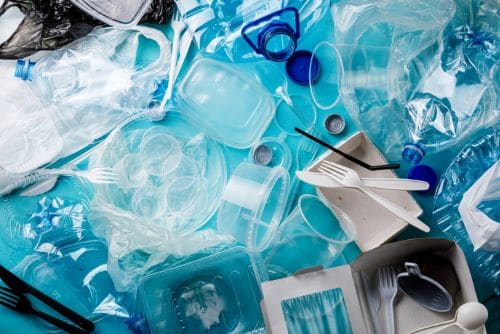When bodies are donated for medical research, scientists closely examine the cadavers. Lately, what they’ve been finding is disturbing.
Professor Rolf Halden is an Arizona State University researcher. He and his colleagues are finding tiny bits of plastic throughout the bodies they look at. It is concentrated in the liver, kidneys, lungs, and spleen, but it’s in other organs as well.
“We have detected plastics in every single organ that we have investigated,” he said.[1]
This is alarming because plastic chemicals are known carcinogens. They are also linked to diabetes, obesity, erectile dysfunction, and infertility. If plastic is in bodies donated to science, it’s in our bodies as well.
Where does all this plastic come from?
It’s everywhere. It has infiltrated the food we eat, the water we drink, and the air we breathe.
Plastic pollution of the world’s oceans is so widespread that plastic is now found in virtually all seafood.
A recent study by the University of Exeter and University of Queensland examined commercially caught seafood. It looked at fish, crabs, oysters, shrimp, and squid. The scientists found small bits of plastic in every single sample.[2]
Microplastics are plastic particles so small that you can’t see them. A 2019 study published in the journal Environmental Science and Technology found they are in drinking water virtually everywhere.[3]
If you drink unfiltered tap water, the study estimates you also take in 4,000 microplastic particles a year. If you drink bottled water, it’s even worse. You ingest 90,000 plastic particles a year. That’s because the plastic in the bottle leaches into the water.
Plastic gets into food crops through irrigation. Microplastics also end up in beef, pork, and poultry through contaminated feed and water.
So far, we haven’t even mentioned the biggest source of plastic poisoning…the air.
Chances are, plastic is in the buttons on your clothes, the glasses on your face, the chair you’re sitting on, and the computer that you’re using to read this article. And that’s just the beginning.
All the plastic we have around us sheds tiny particles that are in the air we breathe. They also settle on everything we touch. A 2018 study published in the journal Environmental Pollution found that most of the microplastic in our bodies comes from dust.[4]
In total, we ingest about five grams of plastic per week, according to the study. That’s the equivalent of eating a credit card.
Plastic is particularly toxic for men:
- A 2014 study at the University of Michigan found that boys and men with more plastic exposure have less testosterone.[5]
- A 2009 study found that boys exposed to high levels of plastic chemicals in the womb are less likely to play with trucks and exhibit less traditional male behavior.[6]
- A 2007 study published in the journal Environmental Health Perspectives found that high plastic levels in men are linked to belly fat and insulin resistance.[7]
- A 2017 study published in the American Journal of Men’s Health found that high plastic levels are associated with erectile dysfunction.[8]
4 Ways to Reduce Plastic Exposure
Unless you want to move to a remote area and live a pre-industrial lifestyle, you can’t rid your body of plastic entirely. But you can reduce your exposure:
1. Invest in a water filter. Chances are, water comes into your home through pipes made from PVC or another plastic called PEX. Both can leach into water. Activated carbon filters remove them.[9] [10]
2. Go glass. Never store or reheat food or beverages in plastic. Use glass or stainless steel. Foods high in fat, like meat and cheese, are especially prone to chemical leaching from plastic. Buy products that come in glass containers instead of plastic ones.[11]
3. Get a HEPA air filter and vacuum. HEPA filters can remove microplastic dust. Put portable HEPA units in areas of your home where you spend the most time. Use a HEPA vacuum cleaner to remove microplastic dust from floors and other surfaces.[12]
4. Replace plastic. The less plastic in your home, the less ends up your body. When shopping, choose items with less plastic… Buy food without plastic packaging. Buy furniture made of wood, metal, or other non-plastic materials. Use a glass or metal water bottle instead of a plastic one. Use a bamboo toothbrush instead of a plastic one.[13]
Plastic may be the most harmful form of pollution in the world today. The worst part? It’s impossible to escape entirely. But you can minimize your exposure and the health damage it causes by taking the steps above.
Editor’s Note: Discover the most effective natural methods to improve your health. Read our monthly journal Independent Healing. It’s your best source for unbiased, evidence-based medical information you won’t find anywhere else. To find out more, go HERE.
Related Articles
Plastic Is Quietly Killing Your Heart
The Great Plastic Water Bottle Scam
Don’t Fall for the Plastics Industry’s Name Game
Like this Article? Forward this article here or Share on Facebook.
[1]https://medium.com/beingwell/our-bodies-consume-a-credit-cards-worth-of-plastic-every-week-a402fe95a092
[2]https://www.medicalnewstoday.com/articles/study-found-plastic-in-every-seafood-sample-it-analyzed
[3]https://www.nationalgeographic.com/environment/2019/06/you-eat-thousands-of-bits-of-plastic-every-year/
[4]https://researchportal.hw.ac.uk/en/publications/low-levels-of-microplastics-mp-in-wild-mussels-indicate-that-mp-i
[5] https://www.webmd.com/men/news/20140814/common-chemicals-may-lower-testosterone-levels-study-finds
[6]https://www.webmd.com/children/news/20091116/phthalates-affect-way-young-boys-play#1
[7]https://www.ncbi.nlm.nih.gov/pubmed/17589594
[8]https://www.ncbi.nlm.nih.gov/pubmed/27036411
[9]https://www.alternet.org/environment/drinking-water-it-safe-when-delivered-through-plastic-pipes
[10]https://www.todayshomeowner.com/are-plastic-water-pipes-safe/
[11] https://www.wikihow.com/Avoid-Phthalates
[12] https://smartairfilters.com/en/blog/what-is-hepa-filter-how-hepa-filter-work/
[13] https://learn.eartheasy.com/guides/the-best-eco-friendly-alternatives-for-the-plastic-in-your-life/

